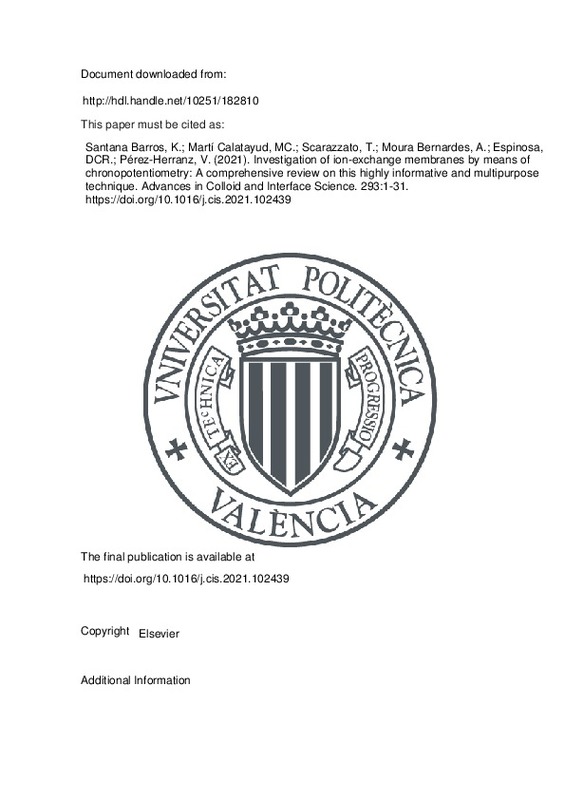JavaScript is disabled for your browser. Some features of this site may not work without it.
Buscar en RiuNet
Listar
Mi cuenta
Estadísticas
Ayuda RiuNet
Admin. UPV
Investigation of ion-exchange membranes by means of chronopotentiometry: A comprehensive review on this highly informative and multipurpose technique
Mostrar el registro sencillo del ítem
Ficheros en el ítem
| dc.contributor.author | Santana Barros, Kayo
|
es_ES |
| dc.contributor.author | Martí Calatayud, Manuel César
|
es_ES |
| dc.contributor.author | Scarazzato, Tatiana
|
es_ES |
| dc.contributor.author | Moura Bernardes, Andréa
|
es_ES |
| dc.contributor.author | Espinosa, Denise Crocce Romano
|
es_ES |
| dc.contributor.author | Pérez-Herranz, Valentín
|
es_ES |
| dc.date.accessioned | 2022-05-23T18:04:06Z | |
| dc.date.available | 2022-05-23T18:04:06Z | |
| dc.date.issued | 2021-07 | es_ES |
| dc.identifier.issn | 0001-8686 | es_ES |
| dc.identifier.uri | http://hdl.handle.net/10251/182810 | |
| dc.description.abstract | [EN] Electrodialysis is mostly used for drinking water production but it has gained applicability in different new fields in recent decades. Membrane characteristics and ion transport properties strongly influence the efficiency of electrodialysis and must be evaluated to avoid an intense energy consumption and ensure long membrane times of usage. To this aim, conducting studies on ion transport across membranes is essential. Several dynamic characterization methods can be employed, among which, chronopotentiometry has shown special relevance because it allows a direct access to the contribution of the potential in different states of the membrane/solution system. The present paper provides a critical review on the use of chronopotentiometry to determine the main membrane transport properties and to evaluate mass transfer phenomena. Properties, such as limiting current density, electrical resistances, plateau length, transport number of counter-ions in the membrane, transition times, and apparent fraction of membrane conductive area have been intensively discussed in the literature and are presented in this review. Some of the phenomena evaluated using this technique are concentration polarization, gravitational convection, electroconvection, water dissociation, and fouling/scaling, all of them also shown herein. Mathematical and experimental studies were considered. New trends in chronopotentiometric studies should include ion-exchange membranes that have been recently developed (presenting anti-fouling, anti-microbial, and monovalent-selective properties) and a deeper discussion on the behaviour of complex solutions that have been often treated by electrodialysis, such as municipal wastewaters. New mathematical models, especially 3D ones, are also expected to be developed in the coming years. | es_ES |
| dc.description.sponsorship | The authors gratefully acknowledge the financial support given by the Brazilian funding agencies CNPq (Process 141346/2016-7, 171241/2017-7, and 160320/2019-4), FAPESP (Process 2012/51871-9) and CAPES (Process 88881.190502/2018-01 and 88887.362657/2019-00). The financial support of Cyted (Network 318RT0551) and ERAMIN2 (FINEP, Brazil and AEI, Spain) is also acknowledged. This study was financed in part by the Coordenacao de Aperfeicoamento de Pessoal de Nivel Superior - Brasil (CAPES) -Finance Code 001. | es_ES |
| dc.language | Inglés | es_ES |
| dc.publisher | Elsevier | es_ES |
| dc.relation.ispartof | Advances in Colloid and Interface Science | es_ES |
| dc.rights | Reconocimiento - No comercial - Sin obra derivada (by-nc-nd) | es_ES |
| dc.subject | Electrodialysis | es_ES |
| dc.subject | Chronopotentiometry | es_ES |
| dc.subject | Current-voltage curve | es_ES |
| dc.subject | Overlimiting phenomena | es_ES |
| dc.subject | Electroconvection | es_ES |
| dc.subject.classification | INGENIERIA QUIMICA | es_ES |
| dc.title | Investigation of ion-exchange membranes by means of chronopotentiometry: A comprehensive review on this highly informative and multipurpose technique | es_ES |
| dc.type | Artículo | es_ES |
| dc.identifier.doi | 10.1016/j.cis.2021.102439 | es_ES |
| dc.relation.projectID | info:eu-repo/grantAgreement/CNPq//171241%2F2017-7/ | es_ES |
| dc.relation.projectID | info:eu-repo/grantAgreement/CAPES//88887.362657%2F2019-00/ | es_ES |
| dc.relation.projectID | info:eu-repo/grantAgreement/CNPq//160320%2F2019-4/ | es_ES |
| dc.relation.projectID | info:eu-repo/grantAgreement/FAPESP//2012%2F51871-9/ | es_ES |
| dc.relation.projectID | info:eu-repo/grantAgreement/CAPES//001/ | es_ES |
| dc.relation.projectID | info:eu-repo/grantAgreement/CNPq//141346%2F2016-7/ | es_ES |
| dc.relation.projectID | info:eu-repo/grantAgreement/CAPES//88881.190502%2F2018-01/ | es_ES |
| dc.relation.projectID | info:eu-repo/grantAgreement/CYTED//318RT0551/ | es_ES |
| dc.rights.accessRights | Abierto | es_ES |
| dc.contributor.affiliation | Universitat Politècnica de València. Departamento de Ingeniería Química y Nuclear - Departament d'Enginyeria Química i Nuclear | es_ES |
| dc.description.bibliographicCitation | Santana Barros, K.; Martí Calatayud, MC.; Scarazzato, T.; Moura Bernardes, A.; Espinosa, DCR.; Pérez-Herranz, V. (2021). Investigation of ion-exchange membranes by means of chronopotentiometry: A comprehensive review on this highly informative and multipurpose technique. Advances in Colloid and Interface Science. 293:1-31. https://doi.org/10.1016/j.cis.2021.102439 | es_ES |
| dc.description.accrualMethod | S | es_ES |
| dc.relation.publisherversion | https://doi.org/10.1016/j.cis.2021.102439 | es_ES |
| dc.description.upvformatpinicio | 1 | es_ES |
| dc.description.upvformatpfin | 31 | es_ES |
| dc.type.version | info:eu-repo/semantics/publishedVersion | es_ES |
| dc.description.volume | 293 | es_ES |
| dc.identifier.pmid | 34058435 | es_ES |
| dc.relation.pasarela | S\460121 | es_ES |
| dc.contributor.funder | CYTED Ciencia y Tecnología para el Desarrollo | es_ES |
| dc.contributor.funder | Fundação de Amparo à Pesquisa do Estado de São Paulo | es_ES |
| dc.contributor.funder | Coordenaçao de Aperfeiçoamento de Pessoal de Nível Superior, Brasil | es_ES |
| dc.contributor.funder | Conselho Nacional de Desenvolvimento Científico e Tecnológico, Brasil | es_ES |







![[Cerrado]](/themes/UPV/images/candado.png)

